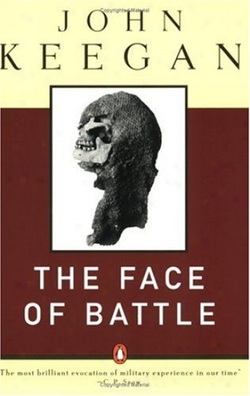
In the Face of Battle, John Keegan explores the experience of soldiering in three significant (and very different) battlefields from British history. He begins with the mud, steel, chivalric culture of Agincourt. The pages turn, and soon the massive infantry squares appear through the gun-smoke shrouds of Waterloo. A century later, hundreds of thousands of soldiers die among the wire and trenches of the Somme.
Keegan adopts a rapidly moving third-person perspective to tell the story of each battle. The book's unusual structure helps Keegan peer deep into the mechanisms of organized violence. He examines the decision-making of generals, but frequently leaves the generals behind to focus on the what the great masses of troops actually saw and did during their respective battles. He examines the weapons and armor of the participants, but also asks about their hometowns and moral outlook. He differentiates between the officers and the enlisted soldiers, and while he does not ask about the source of class divisions, he shows enough interest in them to suggest how such divisions effect behavior on the battlefield. For each battle, he opens with a short examination of the battle's larger context--or at least the campaign of which it was a part. He then examines the particulars of the battle, with its turns, stages, and outcomes. He then assesses the practicalities of the various matchups that occurred. In Agincourt, for example, he asks how archers fared against infantry and cavalry, and what close-combat looked like to an infantryman in 1415. After examining the action, he addresses particular moral puzzles that each arise during each battle. Why did Henry V demand the execution of his French prisoners? Why did the British leave their wounded on the field at Waterloo? Why did soldiers of the First World War propel themselves out of the trenches and into harm's way? He takes what he learns from all this and applies it to a final chapter, where he considers the future of war, and the changes of technology that effect it; he ultimately supposes that war will grow increasingly horrific, regardless of the perks and amenities nations attempt to provide their armies, such as pensions and air conditioned tanks.
Keegan's book celebrates its three battles as moments of human interest, filled with deep failings and horrific exaltations. His emphasis on personal action and individual decision-making wins steep dividends. He recognizes that "ordinary soldiers do not think of themselves, in life-and-death situations, as subordinate members of whatever formal military organization it is to which authority has assigned them, but as equals within a very tiny group...." As a consequence, much of battle consists of leaders attempting to hold individuals to a collective fate, while at the same time trying to break the will of individuals in the opposing force. Thus, he pays keen attention to why Napolean's heavy cavalry units never quite crossed swords with the British infantry squares, but instead skirted their ranks, fled, and charged again. And he shows that French men-at-arms avoided confronting archers, not necessarily because of the danger archers presented, but because could find no honor or monetary reward for attacking and capturing individuals from such a low station.
Keegan, in short, unpacks the physical and psychological effects of warfare from the perspective of the individual, and then assesses the gritty details that make warfare so untenable, yet so horribly persistent throughout the years. As a work of history, Keegan grounds it in three very specific times and places, rather than attempting a generalized psychological exploration of organized violence. It is all the more convincing for his deliberate attempts to evoke specific moments in history: the mud-choked rise of infantry from the trenches, the screaming of horses before a fully-formed square.
 RSS Feed
RSS Feed